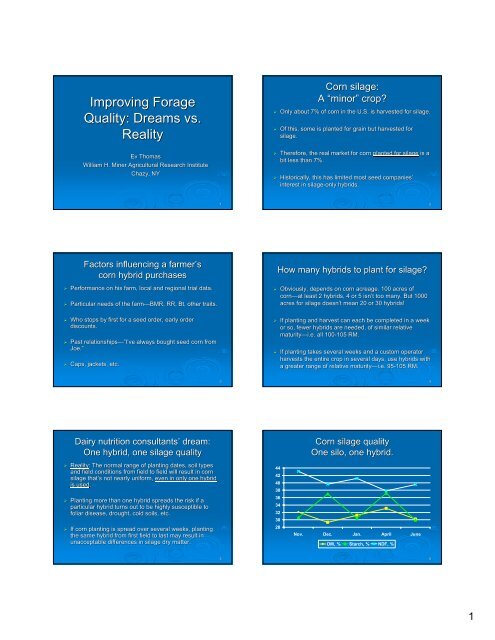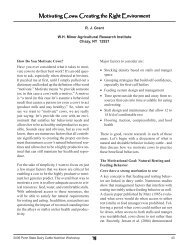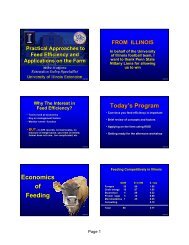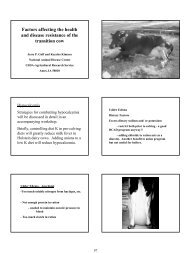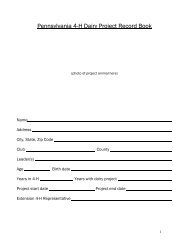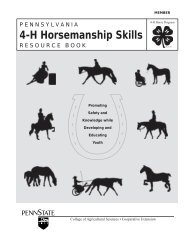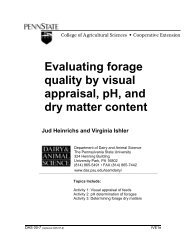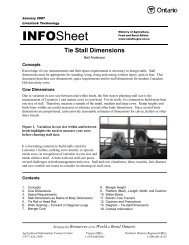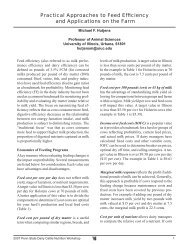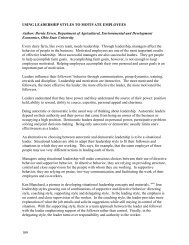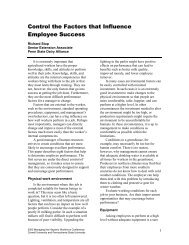Improving Forage Quality: Dreams vs. Reality - Penn State University
Improving Forage Quality: Dreams vs. Reality - Penn State University
Improving Forage Quality: Dreams vs. Reality - Penn State University
Create successful ePaper yourself
Turn your PDF publications into a flip-book with our unique Google optimized e-Paper software.
<strong>Improving</strong> <strong>Forage</strong><br />
<strong>Quality</strong>: <strong>Dreams</strong> <strong>vs</strong>.<br />
<strong>Reality</strong><br />
Ev Thomas<br />
William H. Miner Agricultural Research Institute<br />
Chazy, NY<br />
Factors influencing a farmer’s farmer s<br />
corn hybrid purchases<br />
Performance on his farm, local and regional trial data.<br />
Particular needs of the farm—BMR, farm BMR, RR, Bt, other traits.<br />
Who stops by first for a seed order, early order<br />
discounts.<br />
Past relationships—”I’ve relationships ve always bought seed corn from<br />
Joe.” Joe.<br />
Caps, jackets, etc.<br />
Dairy nutrition consultants’ consultants dream:<br />
One hybrid, one silage quality<br />
<strong>Reality</strong>: <strong>Reality</strong>:<br />
The normal range of planting dates, soil types<br />
and field conditions from field to field will result in corn<br />
silage that’s that s not nearly uniform, even in only one hybrid<br />
is used. used<br />
Planting more than one hybrid spreads the risk if a<br />
particular hybrid turns out to be highly susceptible to<br />
foliar disease, drought, cold soils, etc.<br />
If corn planting is spread over several weeks, planting<br />
the same hybrid from first field to last may result in<br />
unacceptable differences in silage dry matter.<br />
1<br />
3<br />
5<br />
Corn silage:<br />
A “minor minor” crop?<br />
Only about 7% of corn in the U.S. is harvested for silage.<br />
Of this, some is planted for grain but harvested for<br />
silage.<br />
Therefore, the real market for corn planted for silage is a<br />
bit less than 7%.<br />
Historically, this has limited most seed companies’<br />
companies<br />
interest in silage-only silage only hybrids.<br />
How many hybrids to plant for silage?<br />
Obviously, depends on corn acreage. 100 acres of<br />
corn—at corn at least 2 hybrids, 4 or 5 isn’t isn t too many. But 1000<br />
acres for silage doesn’t doesn t mean 20 or 30 hybrids!<br />
If planting and harvest can each be completed in a week<br />
or so, fewer hybrids are needed, of similar relative<br />
maturity—i.e. maturity i.e. all 100-105 100 105 RM.<br />
If planting takes several weeks and a custom operator<br />
harvests the entire crop in several days, use hybrids with<br />
a greater range of relative maturity—i.e. maturity i.e. 95-105 95 105 RM.<br />
44<br />
42<br />
40<br />
38<br />
36<br />
34<br />
32<br />
30<br />
28<br />
Corn silage quality<br />
One silo, one hybrid.<br />
Nov. Dec. Jan. April June<br />
DM, % Starch, % NDF, %<br />
2<br />
4<br />
6<br />
1
Corn hybrid selection<br />
Leafy hybrids<br />
Most leafy hybrids are “silage silage only” only hybrids, but a few<br />
are promoted as dual-purpose<br />
dual purpose—for for grain or silage.<br />
Leafy hybrids have up to twice as many leaves<br />
above the ear. (I’ve (I ve seen as many as 12.)<br />
However, leaves don’t don t add to forage quality, only<br />
represent 10-12% 10 12% of whole plant yield.<br />
(20% more leaves x 10% = 10 + 2 = 12%)<br />
Therefore, there’s there s often less than meets the eye.<br />
However, leafy hybrids are hot!<br />
Why are leafy hybrids hot?<br />
Seed price and yield<br />
similar to non-leafy non leafy<br />
hybrids.<br />
The extra leaves are at<br />
eye level, where<br />
farmers can see them. them<br />
Leafies simply look<br />
great in the field.<br />
Leafies got sex appeal!<br />
7<br />
9<br />
11<br />
In vitro true digestibility (%)<br />
80<br />
75<br />
70<br />
65<br />
Whole plant<br />
y = 0.83x + 73<br />
R 2 = 0.88<br />
Stover<br />
1900-1929 1930-1944 1945-1959 1960-1974 1975-1989 1990-present<br />
Relationship between corn forage in vitro true digestibility and era of<br />
release for whole-plant and stover.<br />
8 leaves<br />
above the ear<br />
Leafy corn<br />
Normal corn<br />
5 leaves above<br />
the ear<br />
Brown midrib (BMR) corn hybrids<br />
Silage-only Silage only hybrids sold by Mycogen Seeds. Still a<br />
tiny portion of the silage market, but increasing.<br />
A naturally-occurring naturally occurring mutation causes incomplete<br />
lignin formation, resulting in high stover digestibility.<br />
Problems: Lower yield, poor standability, lousy<br />
drought and disease tolerance, very high seed price.<br />
Much of the benefit is from improved dry matter<br />
intake; especially good in high corn silage diets and<br />
for high-producing high producing cows.<br />
cows<br />
10<br />
12<br />
2
Normal corn<br />
BMR corn<br />
13<br />
BMR planted May 1<br />
Leafy corn BMR corn<br />
15<br />
17<br />
BMR planted May 1<br />
“Your Your grandfather’s grandfather s corn” corn<br />
The BMR gene was discovered many years ago, but<br />
BMR corn wasn’t wasn t commercialized until the 1990s.<br />
BMR is therefore competing with hybrids that are the<br />
result of 70 years of selection and improvement since<br />
corn was hybridized in the 1930s.<br />
BMR yield and stress tolerance aren’t aren t good<br />
compared to today’s today s best hybrids, more like corn<br />
grown 25 years ago.<br />
14<br />
16<br />
18<br />
3
BMR <strong>vs</strong>. non-BMR non BMR corn silage<br />
105<br />
100<br />
95<br />
90<br />
Average of 18 field and lactation trials<br />
Yield ADF NDF Milk/Ton Milk/Acre<br />
BMR Non-BMR<br />
Corn hybrid selection: Summary<br />
Don’t Don t assume that the newest hybrids have better NDF<br />
digestibility. Rely on university corn silage trials.<br />
Leafies are a good option if they have superior<br />
digestibility. Some do, some, don’t. don t.<br />
BMR: Not for all farms, not for all cows on a farm. Should<br />
be stored in a separate silo. Requires a strong stomach<br />
and a pioneering spirit. (As opposed to a Pioneer-ing<br />
Pioneer ing<br />
spirit.)<br />
<strong>Penn</strong> <strong>State</strong> chop height research<br />
Chop<br />
height<br />
6”<br />
18” 18<br />
Centre County, 2004<br />
Tons/A @<br />
35%DM<br />
26.4<br />
24.6<br />
48 hr<br />
NDF-D NDF<br />
54.9<br />
58.0<br />
Milk/ton<br />
3129<br />
3406<br />
29,169<br />
29,473<br />
19<br />
21<br />
Milk/acre<br />
23<br />
120<br />
115<br />
110<br />
105<br />
100<br />
95<br />
90<br />
85<br />
80<br />
New BMR hybrid =<br />
improved performance?<br />
Two Cornell <strong>University</strong> silage trials, 2005<br />
Yield Milk/t Milk/A Yield Milk/T Milk/A<br />
BMR Trial Ave.<br />
Corn silage chop height height<br />
“Normal Normal” chop height is generally considered to be<br />
6-8”. . In recent years there’s there s been interest (and a lot<br />
of research) on chopping at 12” 12 to 18”, 18 , with some<br />
research at 30” 30 chop height .<br />
High chop corn is a trade-off trade off between reduced yield<br />
and increased silage quality. Yield reduced ~300#<br />
lbs. per inch above 6-8”. 6 .<br />
3-4% 4% higher milk production per ton, but lower fat%.<br />
Chop height realities<br />
Many farmers already chop higher than 6-8” 6 because of<br />
uneven fields and wide chopper heads. 10” 10 not unusual.<br />
Custom harvest operators often chop 10”+, 10 +, especially on<br />
farms where stones are a problem and where the farmer<br />
hasn’t hasn t done a good job of stone picking.<br />
Chop height: “Just Just above the height of the biggest stone<br />
in the field.”<br />
field.<br />
20<br />
22<br />
24<br />
4
Processed corn silage<br />
Chop height: 17”<br />
(continued)<br />
Alfalfa mowing height:<br />
How low should we go?<br />
Yield of alfalfa-grass alfalfa grass hand harvested<br />
at 2” 2 and 4” 4 cutting heights<br />
First<br />
Second<br />
Third<br />
Total<br />
Tons DM/A<br />
2”<br />
2.0<br />
0.8<br />
1.4<br />
4.2<br />
Tons DM/A<br />
4”<br />
1.7<br />
0.7<br />
1.3<br />
3.7<br />
P<br />
0.001<br />
<strong>Forage</strong> quality of alfalfa-grass alfalfa grass mowed<br />
with disk mower at 3.1” 3.1 and 4.3” 4.3<br />
CP, %<br />
NDF, %<br />
Ash, %<br />
NDF-d, NDF d, 24 hr<br />
Milk2000/T Milk2000/T<br />
3.1” 3.1<br />
17.4<br />
49.4<br />
8.6<br />
49.4<br />
2615<br />
4.3” 4.3<br />
17.9<br />
48.7<br />
8.3<br />
53.8<br />
2813<br />
But how about milk per acre?<br />
P<br />
0.144<br />
0.020<br />
0.06<br />


